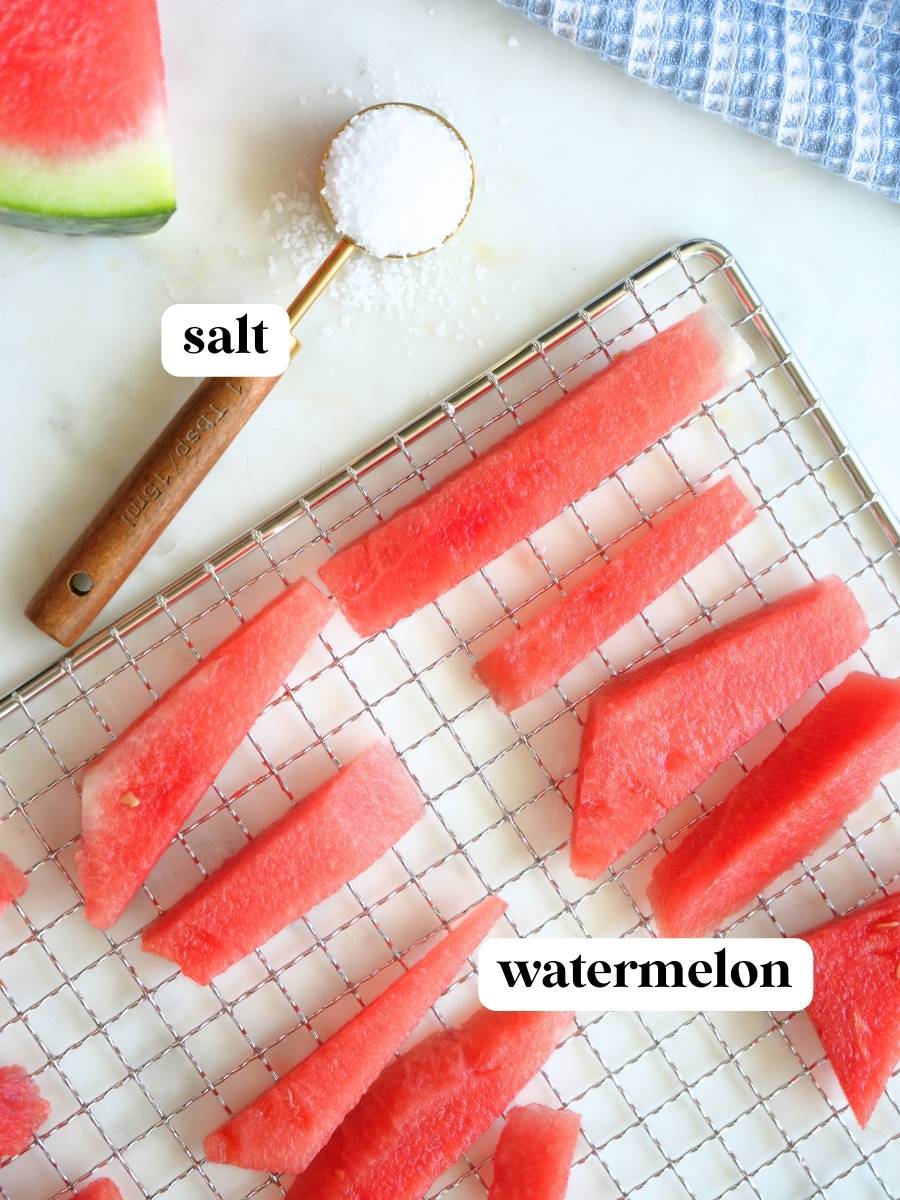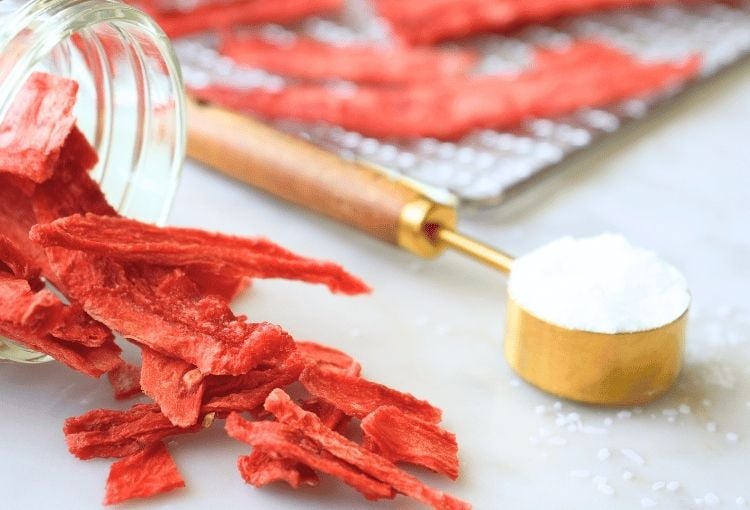This post may contain affiliate links. Please read our disclosure policy.
Learn how to dehydrate watermelon so you can enjoy the sweetness of summer all year long. As sweet as candy, dehydrated watermelon is a healthy snack without added sugar. It’s a perfect snack for kids and the young at heart!

Table of Contents
Summer gardens are gearing up for one of the season’s best treats: watermelon! I’m hoping we have a bountiful watermelon harvest this year because I want to stock our pantry snack shelf with dehydrated watermelon (aka watermelon jerky).
So far this summer, we’ve been devouring garden-fresh dishes like cucumber salad, sourdough peach cobbler, sourdough strawberry shortcake, strawberry ice cream, and Instant Pot stewed tomatoes. But soon, we will be knee-deep in watermelon everything.
Last night, when I was in the garden, I was a little bummed to find that a critter ate not one but two of our watermelons. However, there are a few watermelons the critters haven’t discovered. Fingers crossed that they don’t find them.
(Update: It’s one year later, and I can confirm the critters ate all of our watermelons last year.)
Luckily, you don’t have to have homegrown watermelons for dehydration. As long as you have a food dehydrator and get your hands on a juicy, ripe watermelon, you can easily make watermelon jerky at home.
Learning how to dehydrate watermelon will change your snacking game. It’s a healthy alternative to processed snacks and will satisfy your sweet tooth.
Plus, dehydrating watermelon preserves summer harvests for later in the year. So, if you are embarking on your food preservation journey, this is a great way to get started!

Why You’ll Love Dehydrated Watermelon
- No Added Sugar: We love summer treats like sourdough lemon bars, but I try to keep sugar in check (most of the time). Dehydrated watermelon tastes like candy—without any added sugar!
- Kid-Approved: My little one loves watermelon jerky, and I love that it’s just real fruit. (Ps. Kids also love freeze-dried apples and strawberries).
- Easy: Learning how to dehydrate watermelon is simple. You slice it up and put it in the dehydrator. Then, set it and forget it!
- Summer Food Preservation: Dehydrating watermelon lets you enjoy that sweet, summery flavor year-round.
Ingredients

Watermelon: For the best watermelon jerky, try to find a ripe, seasonal watermelon. Also, I prefer a seedless watermelon.
Salt (optional): A little dash of salt can elevate the watermelon’s natural flavors.
Get the full list of ingredients and measurements on the printable recipe card below.
Tools You Will Need
Food Dehydrator: I use a Cosori food dehydrator and I love it. Vertical dehydrators like the popular Elite Gourment are also good choices.
Step-by-Step Instructions

Step 1: Slice the watermelon into any shape about 1/2 inch thick and at least 1 inch wide. Remove the rind and any large seeds.

Step 2: Place the cut watermelon in a single layer on the dehydrator trays. Don’t crowd the watermelon. It needs circulation to dry fully and evenly.
If sticking is an issue with your trays, line the trays with parchment paper.
Optional: Sprinkle the watermelon with a little salt.

Step 3: Put the trays into the dehydrator and dry at 135° F. Since watermelon has a high water content, it can take a while to dry.
The total drying time depends on your dehydrator and the slices’ thickness. Mine took about 24 hours.

Step 4: Remove the watermelon from the dehydrator when it is dry, malleable, and without signs of stickiness.

Step 5: Let the watermelon cool to room temperature on the trays (packing it up while it’s warm will create condensation and ruin your watermelon jerky).

Step 6: Store in an airtight container in a cool, dry place for 3-12 months (see section below about storing dried watermelon).
Tips for Success
- Long strips of watermelon, about 1/2″ thick, work best. If they are too thick, they take an eternity to dry. If they are too thin, and they stick to the dehydrator trays.
- I recommend cutting the watermelon about 1: wide. Anything smaller shrivels too much and is a pain to peel off the trays.
- A sprinkle of salt can bring out the flavors in dehydrated watermelon. If you prefer, add a little before putting the sliced watermelon in the dehydrator.

How To Store Dehydrated Watermelon
- You can store dehydrated watermelon in the pantry, fridge, or freezer.
- The shelf life of dried watermelon depends on how dry it is when stored and the conditions in which it is stored, and it can range from three months to a year (source).
- Make sure it is stored in an airtight container, preferably one that will allow you to see if any unwanted moisture has developed (moisture and mold go hand in hand).
- If you see any signs of mold or if it smells funny, throw away your dried watermelon.
How to Pick the Best Watermelon
It’s the age-old question: How do you pick a good watermelon? It can be a little hard to tell if a watermelon is good. But if you want to find the holy grail of watermelons, here are a few tips:
Give it a Thump: A good watermelon will resonate when you thump it. It should have a deep, hollow sound.
Look for a Light Patch: A light yellowish patch on a watermelon is called a “field mark.” It’s where the watermelon was resting on the ground while ripening. If it doesn’t have a field mark, that might mean it was picked too soon.
Check the Symmetry: A good watermelon is usually symmetrical in shape.
Lift It: A juicy watermelon is usually heavy.

Dehydrating Watermelon in the Oven
Because of watermelon’s high water content, it could be hard to dehydrate it in the oven.
In full disclosure, I’ve never tried. But it took 24 hours for my watermelon to dry in my dehydrator. So even though it would probably work in the oven, it would take a really long time.
If you want to give it a go, put the watermelon on a wire rack on top of a cookie sheet. Set the heat to 140° F or your oven’s lowest temperature. Keep the oven door cracked to let the moisture escape.
If you try the oven method, leave a comment below and let me know how it went.
FAQs
Yes! Dehydrated watermelon isn’t just good; it’s a delicious snack. It has a chewy texture and is naturally sweet with a burst of watermelon flavor.
Dehydrating watermelon has two-fold benefits. It is a healthy snack to keep around. Also, it is a way of preserving your summer watermelon so that it is shelf-stable for several months or even up to a year.
I prefer a cabinet dehydrator (also called a horizontal dehydrator) because it heats more evenly, and you don’t have to worry about rotating the trays.
The dehydrating time depends on the amount of watermelon juice in the fruit, the thickness of the slices, and the type of dehydrator. It can take up to 12-24 hours.
Keep an eye on it. I recommend checking it around the 8-hour mark and frequently after that. Mine usually takes just under 24 hours to fully dry.
Let’s Connect!
If you tried this recipe and loved it, leave a comment or review below.
Also, don’t forget to pin this post and follow Moon + Magnolia on Pinterest. You can save all my recipes on your boards and keep up with the latest happenings!
Share your creations on Instagram and tag @moon_and_magnolia!


Dehydrated Watermelon
Ingredients
- Watermelon, seeded or seedless
- Salt, optional
Instructions
- Slice the watermelon into any shape that is about 1/2 inch thick and at least 1 inch wide. Cut off the watermelon rind and remove any large seeds.
- Place the cut watermelon in a single layer on the dehydrator trays. Don't crowd the watermelon. It needs circulation to fully and evenly dry. If sticking is an issue with your trays, line the trays with parchment paper. Optional: sprinkle the watermelon with a little salt.
- Put the trays into the dehydrator and dry at 135° F. Since watermelon has a high water content, it can take a while to dry. The total drying time depends on your dehydrator and the slices' thickness. Mine takes about 24 hours.
- Remove the watermelon from the dehydrator when it is dry, malleable, and without signs of stickiness.
- Let the watermelon cool to room temperature on the trays (packing it up while it's warm will create condensation and ruin your watermelon jerky).
- Store in an airtight container in a cool, dry place (see notes about storage).
Notes
- The yield will depend on the size of your watermelon.
- You can store dehydrated watermelon in the pantry, fridge, or freezer. How long your dried watermelon will last depends on how dry it is when stored and the conditions in which it is stored. The shelf life can range from 3 months to a year.
- I recommend checking it around the 8-hour mark and frequently after that.
Nutrition
Nutrition information is auto-calculated and may not reflect your final product. Please verify independently if needed.

Even though I love to bake, I don’t want my little one (or myself) eating baked good every day. This is such a healthy sweet treat!